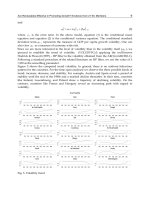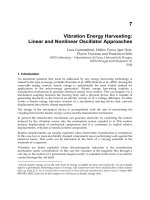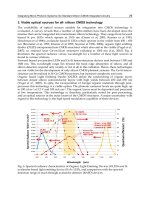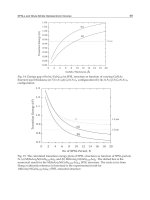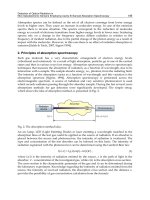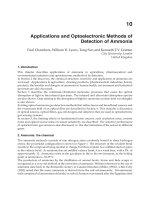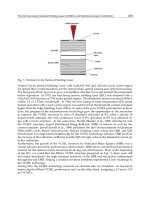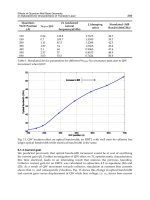Optoelectronics Devices and Applications Part 10 docx
Bạn đang xem bản rút gọn của tài liệu. Xem và tải ngay bản đầy đủ của tài liệu tại đây (1.22 MB, 40 trang )
Part 4
Optical Switching Devices
17
Energy Efficient Semiconductor
Optical Switch
Liping Sun and Michel Savoie
Communications Research Centre
Canada
1. Introduction
Energy-saving technology that reduces power consumption is of increasing importance due
to the ever-increasing demand for Internet services. To prevent the traffic growth from
being strangled by energy bottlenecks, novel architectural and technological solutions are
indispensable. The most obvious way to cope with the issue is to reduce the energy
consumed by the network elements.
Fast optical switching is an important enabler of advanced optical networks, in particular
such functions as routing burst and packet optical signals, optical path provisioning and
fault restoration. Semiconductor Digital Optical Switches (DOSs) can fulfill such high speed
applications due to their nanosecond switching times, step-like switching responses, and
immunity to variations in temperature, wavelength, polarization, refractive index and
device fabrication tolerances. Moreover, semiconductor DOSs offer the potential for
integration with other semiconductor optoelectronic components and thus promise
considerable reductions in the size, complexity and cost of an overall optical system.
For optical waveguide switches, fast optical switching may be achieved by a refractive index
change, induced either by carrier injection (Zegaoui et al., 2009; Bennett et al., 1990) or by the
electro-optic effect (Cao et al., 2009; Agrawal et al., 1995), within III-V semiconductors, such
as GaAs-based and InP-based. Compared to carrier-injection switches, electro-optic switches
have faster switching speeds but larger switching voltages since the refractive index change
induced by an electro-optic effect is about two orders of magnitude smaller than that by
carrier injection.
Therefore, until now, most of the commercially available semiconductor DOS products have
been based on carrier-injection (Ikezawa et al., 2008). These devices typically utilize carrier-
induced Total Internal Reflection (TIR) at a waveguide branching or crossing point to switch
the light path from one waveguide to another. Such TIR-based semiconductor switches
typically require a large index modulation, e.g. in the order of 0.01, with the region of
changed index having a well-defined boundary. Accordingly, efforts have been made to
restrict current spreading and to confine the injected carriers to the desired region.
Typically, achieving such carrier confinement involves using relatively complex
semiconductor device technologies, such as ion implantation (Abdalla et al., 2004; Zhuang et
al., 1996), electron-beam lithography (Shimomura et al., 1992), Zn diffusion (Yanagawa et al.,
1990), and epitaxial regrowth (Thomson et al., 2008).
Optoelectronics – Devices and Applications
352
A plane view of a typical conventional semiconductor DOS is illustrated in Fig. 1(a),
wherein two waveguides intersect at an angle θ forming an -like waveguide structure. An
electrode is provided over a common waveguide region where the waveguides intersect for
injecting carriers into a portion of the common region to decrease its refractive index n by an
amount Δn sufficient to induce TIR for the input beam and to cause it to turn by the angle θ
to form the switched light. In the absence of the carrier injection, i.e. when there is no
current flowing through the electrode, the input light continues its propagation along the
waveguide past the common region to form the transmitted light. In order to switch the
input light, the electrode is positioned so that its edge, which faces the input light, crosses
the input waveguide at an angle θ/2. One drawback of the design in Fig. 1 is that, for
optimal performance, the electrode should be positioned with its ‘receiving’ edge centered
in the common waveguide region. This makes the structure asymmetrical with respect to
the two input waveguides, so that the switch is, essentially, a ‘Y’ switch that can only
function as a 1×2 switch and not as a 2×2 switch.
A typical 2×2 semiconductor TIR DOS with the conventional electrode design is shown in
Fig. 1(b). In order to reduce an optical axis misalignment of the reflected light for both input
ports, the electrode has to be narrow; disadvantageously, a narrow electrode will generally
result in poor reflectivity induced by the current passing through the electrode, leading to a
degradation of the switch extinction ratio, i.e. the optical power ratio for the output ports.
(a) 1×2 (b) 2×2
Fig. 1. Schematic diagrams of TIR optical switches with conventional electrodes.
Fig. 2 is a schematic diagram of a 2×2 switch which has a similar waveguide topology as Fig.
1(b), but utilizes the bow-tie electrode in place of the straight electrode of Fig. 1(b) (Li et al.,
2001). The bow-tie electrode has a narrow part located at the central point of the waveguide
intersection, and the electrode is symmetrical with respect to all four waveguide ends. The
switch has a switching angle θ = 2˚, and an electrode bow-tie angle of 1.5 degrees. The
switch utilizes ion implantation about the electrode to decrease current spreading and
confine the injected carriers. One disadvantage of the prior art bow-tie electrode design is
that its electrode is still narrow at the waveguide crossing point, potentially enabling the
light to leak therethrough under the carrier injection condition. Furthermore, a part of the
incoming light that incidents on the second electrode segment may be refracted rather than
reflected because of the increased grazing angle. All these limit the waveguide crossing
Energy Efficient Semiconductor Optical Switch
353
angle θ of the bow-tie type 2×2 switches to about 2° in real device applications. The small
switching angle increases the size of the device and limits the integration density.
Fig. 2. Schematic diagram of a 22 TIR optical switch with bow-tie electrode.
Another disadvantage of the prior art TIR semiconductor switches is their relatively large
power consumption, especially for devices with the switching angle at the higher end of the
range, as such devices require larger electrical currents. Reconfigurable waveguide DOS
devices with small switching current and low crosstalk have been reported recently
(Zegaoui et al., 2009; Ng et al., 2007), but their branch angle is only 0.9˚. It is therefore
desirable to develop TIR switches with greater deflection angles and reduced power
consumption.
This chapter presents our approaches to improve the energy efficiency of semiconductor
DOSs for applications in next generation green optical networks. In the following sections,
we first propose and demonstrate a novel double-reflection switch design that can reduce
the power consumption and increase the switch deflection angle. Then, in the next section,
an ultra-low-power 2×2 carrier-injection optical switch based on a Mach-Zehnder
Interferometer (MZI) formed by Multi-Mode Interference (MMI) couplers is introduced and
investigated. Conclusions and future applications are provided in the last section.
2. Double-reflection TIR DOS
This section discusses the design, fabrication and characterization of a novel double-
reflection technique to fabricate 1×2 and 2×2 wide-angle AlGaAs/GaAs carrier-injection TIR
optical switches. This new development uses only conventional semiconductor fabrication
technologies to reduce the switching current and relax the tight restriction on the width of
the electrodes located at the switch centre. To compensate for the increased switching
current, compositionally graded interfaces are added at the heterojunctions to reduce the
switching voltage and thus the power consumption. Switching performance is further
improved by applying curved electrodes and carrier-restriction gaps.
2.1 Double-reflection structure
Our approach to improve the performance and reliability of 1×2 and 2×2 TIR optical
switches with a double-reflection electrode geometry is illustrated in the two pictures shown
Optoelectronics – Devices and Applications
354
in Fig. 3 below. The electrode in Fig. 3(a), which utilizes a well known ‘Y’-shaped
waveguide structure, is shaped to induce double reflection of the input light. Its first edge
faces the input waveguide and is positioned for turning, in the presence of the carrier
injection, the input light by a first deflection angle θ
1
, so as to form the first reflected light
that propagates generally towards the second edge. The second edge is positioned for
turning the first reflected light by a second angle θ
2
towards the switched output waveguide
for coupling thereinto as the switched light. This electrode is also shaped and positioned so
that, in the absence of the carrier injection, substantially all or at least most of the input light
passes under the first edge of the electrode. This design also results in that in the presence of
the carrier injection through the electrode, substantially all or at least most of the input light
is reflected at the first edge. Note that this feature differentiates the electrode of Fig. 3(a)
from the prior art bow-tie electrode of Fig. 2, wherein the input light impinges upon two
inclined edges of the bow-tie in substantially equal portions, so that only about half of the
input light passes under each bow-tie edge, resulting in a loss of input light since for a large
switch branching angle the part of input light that directly incidents on the second edge of
the electrode will not be reflected under TIR due to their increased grazing angle.
first input
second output
double-reflection
electrode
first output
second input
(a) 1×2 (b) 2×2
Fig. 3. Schematic diagrams of TIR optical switches with double-reflection electrode.
Continuing to refer to Fig. 3(a), in a further advantage each of the first and second deflection
angles is less than the light switching angle θ, and therefore the switching of the input light’s
direction by the switching angle θ may be accomplished by a smaller refractive index
change Δn under the electrode, and thus using a smaller injection current than would have
been required for the conventional single-reflection electrode design such as that of Fig. 1.
In one currently preferred electrode geometry design, the first and second angles θ
1,
θ
2
are
both equal to one half of the branching angle θ, i.e. θ
1
= θ
2
= θ/2.
Advantageously, this double-reflection structure enables to have the switching angle θ twice
as large as in the conventional single-reflection design for the same refractive index change
Δn in the index change region, or, alternatively, to turn the light by the same angle θ using
only half of the electrical current. Indeed, the reflective index change Δn that is required to
induce the TIR at the first and second edges may be estimated from an approximate TIR
condition,
θ
i
≤ Δn/n, i =1, 2, (1)
Energy Efficient Semiconductor Optical Switch
355
which approximately holds for Δn/n << 1 and the angles θ
i
measured in radians, so that
reducing the turning angle by a factor of 2 reduces the required index change by the same
factor.
The double-reflection structure that has been described above for 1×2 optical switches, can
be easily adopted for 2×2 switches, such as schematically shown in Fig. 3(b), by adding a
second input waveguide and by symmetrically extending the double-reflection electrode so
as to provide a second pair of electrode edges for switching the light from the second input
waveguide into the first output waveguide by means of double reflection at the third and
fourth electrode edges. In the 2×2 switch, the second input waveguide is optically aligned
with the second output waveguide so that, in the absence of the carrier injection, input light
from the second input waveguide will be transmitted by the branching section into the
second output waveguide. In the presence of the carrier injection, light that enters from the
second input waveguide experiences two consecutive reflections at the third and fourth
edges and is directed into the first output waveguide, while light that enters from the first
input waveguide also experiences two consecutive reflections at the first and second edges
as described before, and is directed into the second output waveguide. The waveguide and
electrode edge structure of the 2×2 switch is substantially symmetrical with respect to an
axis of symmetry which bisects the waveguide branching angle. In Fig. 3(b), the electrode is
shaped as an ‘’, with two cut-outs around the symmetry line in the input and output
portions of the structure, so as to reduce the scattering optical loss, the total electrical current
required for the switching, and therefore to reduce the power consumption and device
heating.
The aforedescribed double-reflection switching addresses important drawbacks of the prior
art TIR-based optical switches. It eliminates the optical misalignment problem and electrode
width problems of the straight and bow-tie electrodes in the 2×2 switching configurations.
As a result, at the same switch crossing angle, the index change, and hence the injection
current density, that is required by the TIR condition needs to be only half of that of the
prior art “single reflection” design, thereby reducing the injection current density by half for
the same switch crossing angle θ. On the other hand, if the same switching current density is
to be used as in the prior art TIR-based switches, the switch crossing angle can be doubled,
making the overall device more compact and thus allowing more devices to be integrated on
a wafer. This newly developed technique enables optical switching at greater waveguide
crossing angles θ and/or smaller induced refractive index changes, and thus smaller power
consumption.
One potential disadvantage of the aforedescribed multi-reflection switch configuration is
that, for the same switch crossing angle θ, the overall area of the switch electrode may be as
much as two times larger than that of the prior art single-reflection electrodes, which may
partially negate the effect of the reduced current density upon the total power consumption
of the device; the larger electrode area and a relatively more complex waveguide branching
area may also lead to an increase in the scattering optical loss in the waveguide branching
region. Advantageously, these two potentially deleterious effects decrease dramatically by
increasing the switch crossing angle θ, and may be reduced to an acceptable level at least for
θ greater than about 3-4°.
2.2 Curved electrodes
A schematic layout of our proposed 2×2 switch with double-reflection structure is shown in
Fig. 4. Each of the four segments of the switch electrode is curved in a logarithmic spiral
Optoelectronics – Devices and Applications
356
shape instead of the conventional straight electrode. This electrode-curvature has been
theoretically studied and reported that it could provide high power reflectivity, high
extinction ratio, and low scattering loss (Nayyer et al., 2000).
Fig. 4. Schematic layout of a proposed 2×2 double-reflection TIR optical switch.
The fabricated optical switch has the two input waveguides and two output waveguides
extended with curved waveguide sections embodied as cosine bends, with a functional form
[h/2-(h/2)cos( x/l)], where h is the height of the bend, l is the length of the bend, and x is
the horizontal propagation length. The device further included a top contact pad to provide
an electrical contact to the switching electrode for delivering current to the switch electrode.
To reduce the crosstalk at the waveguide crossing, adiabatic tapers are used in the
waveguide branching region. This waveguide widening can also provide more fabrication
freedom for the electrode. As shown in the figure, the double-reflection design enables us to
set the electrode width at several times larger than the light penetrating depth and hence
provide a sufficient index change for TIR and large extinction ratio.
Fig. 5. The waveguide layer structure which specifies the composition (Al
x
Ga
1-x
As), doping
profile, and layer thickness for each layer.
Energy Efficient Semiconductor Optical Switch
357
Fig. 5 is a schematic diagram of the vertical cross-section of the waveguide structure that we
used for the 2×2 switch along the line ‘A-A’ shown in Fig. 4. The switch’s strip-loaded
waveguide design has a multilayer heterostructure with a W-shaped index profile. The
waveguide core layer of GaAs is 1.7 μm thick, and is, to the best of our knowledge, the
largest ever reported for a single-mode semiconductor DOS. It provides high coupling
efficiency to a single mode fibre.
2.3 Current restriction gap
At the TIR interface inside our switch design, a small isolation gap is introduced between
the electrode and waveguide to restrict the current spread into the waveguide regions not
covered by the electrode, and to obtain a sharp carrier gradient profile for improved
switching efficiency. This current restriction effect of the isolation gap is schematically
illustrateed in Fig. 6. It also schematically shows an effective reflection interface wherein the
reflection of the guided light occurs in the presence of the carrier injection. When the
switching voltage V
b
is applied between the switching electrode and a bottom contact, the
switching electrical current flows through the current flow region indicated by cross-
hatching. Although the gap substantially reduces the current spread into the regions not
directly under the switching electrode, it does not eliminate the spreading completely,
resulting in the possibility of a small lateral offset of the effective reflection interface from
the reflection edge of the electrode. This offset however may be rather small, for example on
the order of less than 1 μm, and is smaller than the size of the waveguide branching region.
Fig. 6. Schematic diagram of the optical mode, the current flow region and the reflective
interface induced by the carrier injection in the cross-sectional view of Fig. 4 taken along the
line ‘B-B‘.
The carrier-induced index variation at the reflection interface is gradual due to the spatial
spreading of injection current flow. If an abrupt spatial variation in the carrier concentration
or current flow can be formed along the reflection interface, more light can be reflected to
the other port. If the waveguide core layer is very thick, it is important to check how the
current restriction gap affects the spreading carrier-induced index change profile at the
reflection interface.
Fig. 7 is the calculated carrier concentration along line ‘C-C’, the middle of the core layer, in
the cross-section as shown in Fig. 6 with or without a separation gap inside the splitting
Optoelectronics – Devices and Applications
358
region, respectively. Fig. 7 was generated based on a two-dimensional simulation of n by
using ApSys, a 2D/3D FEM optoelectronic simulation software from Crosslight Software
Inc., and is based on a top electrode that is 200 m long and with a bias current of 200 mA.
Only the structure from the centerline of the biased waveguide is shown in Fig. 7. The
dotted line in Fig. 7 is the edge of the top electrode. As illustrated in Fig. 7, an isolation gap
in the splitting region is needed to prevent carriers from spreading beyond the electrode
region. The self-heating effect was also included in the 2D FEM simulation. In the
simulation, the room temperature is set at 300 K and the heat generated from contact
resistance was not included. Calculation shows that the guiding of light to the destination
port via modal evolution is unchanged with or without the self-heating temperature change.
Fig. 8 is the corresponding carrier-induced refractive index change n along the middle of
the core layer with or without a separation gap in the splitting region, respectively. The
calculation involves a combination of bandfilling, band-gap shrinkage, and plasma effect
(Bennett et al., 1990). The maximum index change is calculated to be -0.037 at the midpoint
of the biasing electrode. The TIR interface located under the electrode edge is 2.5 m apart
from the biased waveguide centre. By introducing a current restriction gap inside the switch
structure, the index change profile at the reflection interface is much more sharp than a
switch without a gap inside. Clearly, more light can be steered into the higher-index
waveguide by introducing a small gap in the splitting region.
distance from the biased wave
g
uide centre
(
m
)
0.0 2.5 5.0 7.5 10.0 12.5 15.0 17.5 20.0
carrier concentration (x10
18
cm
-3
)
0.0
0.2
0.4
0.6
0.8
1.0
1.2
1.4
1.6
ridge waveguides with gap inside
ridge waveguides with no gap inside
Fig. 7. Carrier concentration along the middle of core layer in the cross section at the
junction branching point. The dotted line is the edge of the top electrode.
Energy Efficient Semiconductor Optical Switch
359
distance from the biased waveguide centre (m)
0.0 2.5 5.0 7.5 10.0 12.5 15.0 17.5 20.0
n
-0.040
-0.035
-0.030
-0.025
-0.020
-0.015
-0.010
-0.005
0.000
ridge waveguides with gap inside
ridge waveguides with no gap inside
Fig. 8. Carrier-induced refractive index change n along the middle of core layer in the cross
section at the junction branching point. The dotted line is the edge of the top electrode.
2.4 Graded heterojunction interfaces
The up-to-date growth technology of Metal-Organic Chemical Vapor Deposition (MOCVD)
enables us to build semiconductor materials with precise control of thickness and
composition at the atomic level. If no grading of the chemical composition of the
semiconductor is applied in the vicinity of the heterostructure, all the heterojunction
interfaces of the fabricated waveguide using the layer structure shown in Fig. 5 are sharply
defined at atomic-level precision. One of the problems introduced by abrupt heterostructure
is the band gap discontinuities caused by free charge transferring at the heterojunction
between two semiconductors with different bandgap energy (Capasso et al., 1987). Carriers
in the large-bandgap material will diffuse over to the small-bandgap material where they
occupy band states of lower energy. As a result of the carrier transfer, and electrostatic
dipole forms and leads to the band bending. For example, most published results for the
Al
x
Ga
1-x
As/GaAs heterojunction indicate that the conduction band discontinuity E
C
0.24
eV for x=0.30 (Wang, 1986).
Fig. 9 is the calculated band diagram of the zero-biased waveguide using the abrupt layer
and doping structure shown in Fig. 5. The numerical simulation software (the APSYS of
Crosslight Software) uses the FEM method to solve a 2D Poisson’s equation for potential
voltage, continuity equation for carriers, and thermionic emission theory for a bandgap
barrier at the heterojunction interface. The adaptive mesh points were set to be very dense
near the heterojunction in order to calculate the bandgap barrier correctly. The band spikes
shown in Fig. 9 at the double-heterostructure interfaces near the lower confinement layer
will suppress the flow of charge carriers across the junction. This band–barrier rectification
effect reduces the carrier injection efficiency of the switch. It is therefore desirable to
eliminate such spikes in the conduction or valence band.
Optoelectronics – Devices and Applications
360
Distance (µm)
0123456
Electron Energy (eV)
0
N
Al
0.4
Ga
0.6
As
N
Al
0.1
Ga
0.9
As
N
GaAs
E
C
E
V
N
+
GaAs
P
Al
0.1
Ga
0.9
As
Fig. 9. Band diagram of the zero-biased waveguide using the abrupt layer and doping
structure shown in Fig. 5.
Composition grading is a common technique in the design of quantum-well lasers, Hetero-
junction Bipolar Transistors (HBTs) and modulation-doped transistors. The compositional
grading at the junction interface can smooth out a large part of the band discontinuity so
that the carrier injection is increased. Usually a graded barrier with a grading length of a few
hundred angstroms can effectively minimize the inference of the band spike at the abrupt
interface. The smaller the carrier concentration on either side of the heterojunction, the
wider the graded region has to be in order to reduce the spike height. The composition
grading effects on band spikes are clearly demonstrated in Fig. 10, which shows the
calculated conduction band profiles for the double-heterostructure interfaces at the lower
confinement layer. Three cases were studied, varying the length of grading width L. The
three simulations are for L=0, L=200 Å and L=400 Å using the layer structure shown in Fig.
5. The metallurgical grading of Al
x
Ga
1-x
As was set linear in the grading region.
Distance (um)
-0.5 -0.4 -0.3 -0.2 -0.1 0.0 0.1 0.2 0.3 0.4 0.5
Electron Energy (eV)
-0.05
0.00
0.05
0.10
0.15
0.20
0.25
0.30
0.35
L = 0 Å
L = 200 Å
L = 400 Å
N
Al
0.1
Ga
0.9
As
N
Al
0.4
Ga
0.6
As
N
GaAs
Fig. 10. Conduction band profiles for the double-heterostructure near the lower confinement
layer at different grading width L.
Energy Efficient Semiconductor Optical Switch
361
The most important advantage of applying graded heterojunctions in the switches is that the
reverse bias problem in a multilayer switch structure can be significantly reduced. The n-n
heterojunction between Al
0.4
Ga
0.6
As and Al
0.1
Ga
0.9
As at the bottom of the lower confinement
layer (see Fig. 5) would be reverse biased when a voltage is applied to operate the switch.
From our simulations, over 80% of the switch driving voltage is applied across the reverse
biased n-n heterojunction when all heterojunctions are abrupt. As shown in Fig. 10, this
abrupt n-n heterojunction barrier can be effectively reduced or completely eliminated by
over 400 Å-length grading. As a result, the switching voltage is further reduced.
2.5 Exemplary demonstrations
A prototype 22 carrier-injection optical switch with double-reflection electrode has been
developed and fabricated. The waveguide structure, as shown in Fig. 5, has six
AlGaAs/GaAs layers grown by MOCVD on an n+ GaAs substrate. For a single-mode
waveguide at a wavelength of the input light of 1.55 μm, the ridge width of 5.0 μm was
used, with the ridge height of about 1 μm. The GaAs waveguide core layer is lightly doped,
n=10
16
cm
-3
, to provide an optimized trade-off between low propagation loss and low
switching voltage. In order to reduce energy band discontinuities at the heterojunctions that
would impede the current flow therethrough, and to reduce the switching voltage,
compositionally graded interfaces 20 nm - 40 nm thick were used at all the layer interfaces.
The width of the current restriction gap, as illustrated in Fig. 6, is about 1 μm. These gaps
may be formed using a double mask technique (van der Tol et al., 1994) to overcome
photolithography problems when forming small gaps. With this technique, two masking
stripes, which are independently defined in separate lithographic steps, can also be used as
masks in a dry etch process to obtain ridge waveguides with small isolation gaps.
Fig. 11 is a Scanning Electron Microscope (SEM) image of the fabricated switch with the
input waveguides on the left, viewed from an angle. It should be noted that the fabrication
processes only employ conventional technologies, such as UV photolithography, e-beam
evaporation and plasma etching. Independently formed electrode and photoresist layers
were used as a double-mask in a single dry etch process to form the ridge waveguides and
gaps. Uniform gap spacing was obtained using vernier alignment marks with 0.1 m
alignment accuracy. Fig. 12 is a SEM picture of the fabricated carrier-restriction gap, with
the sample cleaved at a location close to the branching vertex of output waveguides.
Fig. 11. SEM image of a fabricated 22 double-reflection TIR optical switch.
550
m
Optoelectronics – Devices and Applications
362
The fabricated switch has an electrode length of 550 m, a waveguide crossing angle of 7,
and a cosine-bend section of 6.4 mm. The measured propagation losses of straight
waveguides with undoped and lightly doped core layers are 0.3 dB/cm and 1.5 dB/cm,
respectively, for a wavelength of 1.55 m. Fig. 13 is the measured switching curves for light
coupled into the top left input port. The switched state was obtained for an injection current
of 220 mA. At this state, the driving voltage was 2.89 V and the measured device series
resistance was 9.8 . So the total power dissipation was at a manageable level of 0.6 W. With
the area of the fabricated electrode being 3400 m
2
, the corresponding switching current
density was 6.5 kA/cm
2
. By using this current density and assuming a 10 ns carrier lifetime,
the estimated carrier density and n are about 210
18
cm
-3
and -0.02, respectively. Such a
high index change may be the result of two facts: one is that the carrier lifetime is quite long
in the thick core layer; the other is that the current spreading decreases at very high current
densities which results in current “bunching” in the core below the isolation gap and hence
yields better power reflectivity. The measured switching time is 15 ns. On-off extinction
ratio is 13 dB for the through port and 14 dB for the switched port. The switch is wavelength
independent for a wavelength range from 1540 nm to 1570 nm. A very small polarization
dependence of TE and TM modes has been observed (<0.5 dB). The measured extra
insertion loss of the 22 switch compared with the straight waveguide fabricated on the
same chip is 3 dB.
Fig. 12. SEM image of the carrier-restriction gap in an angled view of Fig. 4 taken along the
line B-B.
Similarly, we also developed a 12 double-reflection optical switch which has a measured
total power dissipation of 0.24 W with no extra cooling required to keep the switched state.
As shown in Fig. 14, the fabricated switch has an electrode length of 480 m, and a
waveguide crossing angle of 6. Based on the measured switching curve shown in Fig. 15,
the switched state was obtained for an injection current of 105 mA at a bias of 2.30 V. The
on-off extinction ratio is 15 dB for the through port and 14 dB for the switched port. The
measured extra insertion loss of the 12 switch is 2 dB compared with the straight
waveguide fabricated on the same chip. The switch is wavelength independent for the
measured C-band. The polarization dependence of TE and TM modes input lights has been
found to be less than 0.5 dB. The measured switching time is 11 ns which is close to the
electrode waveguide
Energy Efficient Semiconductor Optical Switch
363
carrier lifetime in bulk materials. Reducing the guiding layer thickness would increase the
switching speed but at the cost of decreasing the fibre coupling efficiency.
Injection Current (mA)
0 50 100 150 200 250
Nomalized Output Power
0.0
0.2
0.4
0.6
0.8
1.0
reflected light
through light
Fig. 13. Measured switching characteristics of a fabricated 22 double-reflection TIR optical
switch.
(a) Layout of the curved double-reflection electrode design
(b) SEM image of a fabricated 12 double-reflection TIR switch
Fig. 14. 12 TIR optical switch with curved double-reflection electrode.
480m
Optoelectronics – Devices and Applications
364
Injection Current (mA)
0 102030405060708090100110
Nomalized Output Power (dB)
-16
-14
-12
-10
-8
-6
-4
-2
0
reflected light
through light
Fig. 15. Measured switching curve of a fabricated 12 double-reflection TIR optical switch.
3. 22 MMI-MZI DOS
To further reduce the switch power consumption, we have developed a 22 GaAs-GaAlAs
carrier-injection switch based on a Mach-Zehnder Interferometer (MZI) formed by two
Multi-Mode Interference (MMI) couplers. In an MZI-based switch (Cao et al., 2009; Wong et
al., 2005), the two MZI arms are formed by two identical single-mode waveguides with
electrodes, fabricated on the top of the waveguides, which allow the variation of the phase
difference between them, based on the carrier-injection effect. Compared to the TIR
switches, MZI-based switches can offer a high on-off extinction ratio and avoid the electrode
fabrication complexity. More importantly, the injected current required to achieve phase
difference between the MZI arms is much smaller than that to achieve TIR, and therefore the
power consumption of the MZI switches is much lower than that of the TIR devices.
A schematic of the fabricated 22 MMI-MZI carrier-injection switch is illustrated in Fig. 16,
the device consists of an MZI configuration in which two 2×2 identical MMI couplers are
connected by two identical parallel single-mode waveguides, that act as the two MZI arms.
Metal electrodes are fabricated on the top of each MZI arm. Each electrode is 250 µm long
and 5 µm wide. The MMI couplers are used as the 3-dB optical power splitter and combiner
because of their polarization insensitive, fabrication and wavelength-tolerant properties
(Besse et al., 1994). The MMI width is 20 µm and the MMI length is 1983 µm. The access
(input/output) waveguides are single-mode waveguides with a width of 5 µm. Each access
waveguide has two short straight sections sandwiching a long s-bend section to facilitate
mode relaxation. The s-bend is designed in such a way that the additional loss caused by
bending in this section is negligible.
Energy Efficient Semiconductor Optical Switch
365
Fig. 16. Schematic diagram of a 22 MMI-MZI carrier-injection optical switch.
The separation between the input (output) ports is 250 µm and that between two electrodes
is 35 µm. The total length of the device is about 1.4 cm. The operational principle of the 2×2
MMI-MZI switch is as follows. If two identical 2×2 MMI couplers are connected together,
the two light beams, equally split from the input light by the first MMI coupler, will merge
again after passing through the second MMI coupler but in the cross state. When sufficient
carriers are injected into one of the electrodes to produce a phase difference between the
MZI arms, the device changes to the bar state.
The 2×2 MMI-MZI carrier-injection switch is fabricated on the epitaxial layer structure
similar to the ridge waveguide structure shown in Fig. 5, with the core layer and two nearby
confinement layers undoped. Compositionally graded interfaces 20 nm - 40 nm thick were
used at all the layer interfaces to reduce energy band discontinuities at the heterojunctions.
The calculated propagation loss of this single-mode waveguide is 0.19 dB/cm for the TE
mode and 0.21 dB/cm for the TM mode.
The measured normalized output power at Output Ports 1 and 2 as a function of the injected
current of Electrode 1 is shown in Fig. 17. The input light at wavelength 1.55 µm is coupled
into the device at Input Port 2. As shown in Fig. 17, the first cross state (Output Ports 1 and 2
are on and off, respectively) occurs at 15.8 mA, and the first bar state (Output Ports 1 and 2
are off and on, respectively) occurs at 44.3 mA. The measured on-off extinction ratio is 20.6
dB for the cross state and 21.5 dB for the bar state. The measured voltage applied to the
electrode is 1.35 V for the cross state and 1.48 V for the bar state. Therefore, the
corresponding power consumption is 21.3 mW for the cross state and 65.6 mW for the bar
state. Because of this very low power consumption, no extra cooling is required to maintain
stable switch operation, which has been observed in our measurements. On the other hand,
such low power consumption is very important for building the future optical Green
Internet. From Fig. 17, we can obtain that the injected current required to achieve phase
difference between the MZI arms is 28.5 mA, which is very close to the theoretically
estimated value of 29.4 mA by considering the guiding layer as an intrinsic semiconductor
bulk material. Compared to the straight waveguides, the fabricated MMI-MZI devices have
almost no measurable additional loss due to the MMI couplers and bend waveguides. The
measured propagation loss of straight waveguides is typically around 0.5 dB/cm for a
wavelength of 1.55 µm and has very small polarization dependence (< 0.5 dB). Based on
Optoelectronics – Devices and Applications
366
these observations, the estimated total on-chip insertion loss would be about 2 dB. The
measured switching time of 15 ns is close to the carrier lifetime in the GaAs bulk material.
Reducing the guiding layer thickness below 0.5 µm would increase the switching speed to a
few ns but at the cost of decreasing the fibre coupling efficiency. It is noted that the switch
should be at the cross state when no current is injected but this is not the case as shown in
Fig. 17 due to the asymmetrical structure of the device because of fabrication errors.
Fig. 17. Switching curves of the 2×2 MMI-MZI optical switch as a function of the injected
current of Electrode 1. A light at wavelength 1.55 µm is coupled into the device at Input Port
2. The output optical power is measured at Output Ports 1 and 2.
4. Conclusions
Wide-angle 12 and 22 AlGaAs/GaAs TIR DOSs were developed by using only
conventional semiconductor device fabrication technologies, suitable for monolithic circuit
integration due to their small size. The developed 22 switch has a 7 waveguide crossing
angle and a manageable maximum 0.6W dc power consumption. The 12 switch has a 6
branching angle and maximum quarter Watt dc power consumption. They can serve as the
basic building blocks for high dense switching matrix. The techniques that we used, such as
carrier restriction gap, curved electrodes, double-reflection interfaces and graded
heterojunctions, can be easily applied to other switches made with other materials such as
InP based, SiGe heterostructures and alike.
An ultra-low-power 22 MMI-MZI DOS with maximum 66 mW power consumption has
also been demonstrated. Such an optical switch has a low insertion loss, high on-off
extinction ratio, and very low power consumption. This device, together with the above TIR
DOSs, will have significant importance in energy savings for future optical Green Internet
applications, when the traffic moves down from the packet switching/routing layer to the
circuit switching layer. The use of dynamic optical path-switching networks will help to
accommodate users with massive video-based service demands in the future.
Energy Efficient Semiconductor Optical Switch
367
5. References
Abdalla, S., Ng, S., Barrios, P., Celo, D., Delage, A., El-Mougy, S., Golub, I., He, J-J, Janz, S.,
McKinnon, R., Poole, P., Raymond, S., Smy, T.J. & Syrett, B. (2004). Carrier
Injection-Based Digital Optical Switch With Reconfigurable Output Waveguide
Arms, IEEE Photonics Technology Letters, Vol.16, pp. 1038-1040, ISSN 1041-1135.
Agrawal, N., Weinert, C. M., Ehrke, H.J., Mekonnen, G.G., Franke, D., Bornholdt, C. &
Langenhorst, R. (1995). Fast 2x2 Mach-Zehnder Optical Space Switches Using
InGaAsP-InP Multiquantum-Well Structures, IEEE Photonics Technology Letters,
Vol.7, pp. 644-645, ISSN 1041-1135.
Bennett, B. R., Soref, R.A. & Alamo, J.A.D. (1990). Carrier-Induced Change in Refractive
Index of InP, GaAs, and InGaAsP, IEEE Journal of Quantum Electronics, Vol.26, pp.
113–122, ISSN 0018-9197.
Besse, P.A., Bachmann, M., Melchior, H., Soldano, L.B. & Smit, M.K. (1994). Optical
Bandwidth and Fabrication Tolerances of Multimode Interference Couplers, IEEE
Journal of Lightwave Technology, Vol.12, pp. 1004-1009, ISSN 0733-8724.
Cao, S., Noad, J., Sun, L., James, R., Coulas, D., Lovell, G. & Higgins, E. (2009). Small AC
Driving Voltage for MZI-Based GaAs-GaAlAs Electrooptic Modulators/Switches
with Coplanar Electrodes,” IEEE Photonics Technology Letters, Vol.21, pp. 584-586,
ISSN 1041-1135.
Capasso F. & Margaritondo, G. (Eds.) (1987). Heterojunction Band Discontinuities, Elsevier
Science Ltd, ISBN 978-0444870605, Amsterdam.
Ikezawa, K., Iio, S., Suehiro, M., Suzuki, T. & Uneme, S. (2008). Demonstration of
Modulation Format Free and Bit Rate Free Characteristics of 2 ns Optical Switch for
Optical Routers, Proceedings of Optical Fiber Communication Conference and Exposition,
no. JWA31, ISBN: 978-1-55752-856-8, San Diego, CA, USA, Feb 2008.
Li, B. & Chua, S.J. (2001). 2x2 Optical Waveguide Switch with Bow-Tie Electrode Based on
Carrier-Injection Total Internal Reflection in SiGe Alloy, IEEE Photonics Technology
Letters, Vol.13, pp. 206-208, ISSN 1041-1135.
Nayyer, J., Niayesh, K. & Yamada, M. (2000). Dynamic Characteristics of Optical
Intersecting-Waveguide Modulators/Switches with Curved Electrodes, IEEE
Journal of Lightwave Technology, Vol.18, pp. 693-699, ISSN 0733-8724.
Ng, S., Janz, S., Mckinnon, W.R., Barrios, P., Delage, A. & Syrett, B.A. (2007). Performance
Optimization of a Reconfigurable Waveguide Digital Optical Switch on InGaAsP–
InP, IEEE Journal of Quantum Electronics, Vol.43, pp. 1147-1157, ISSN 0018-9197.
Shimomura, K., Tanaka, N., Aizawa, T. & Arai, S. (1992). 2V Drive-Voltage Switching
Operation in 1.55m GaInAs/InP MQW Intersectional Waveguide Optical Switch,
Electronics Letters, Vol.28, pp. 955-956, ISSN 0013-5194.
Thomson, D., Gardes, F.Y., Mashanovich, G.Z., Knights, A.P. & Reed, G.T. (2008). Using
SiO
2
Carrier Confinement in Total Internal Reflection Optical Switches to Restrict
Carrier Diffusion in the Guiding Layer, IEEE Journal of Lightwave Technology, Vol.26,
pp. 1288-1294, ISSN 0733-8724.
van der Tol, J.J.G.M., Pedersen, J.W., Metaal, E.G., Ose, Y.S., Groen, F.H. & Demeester, P.
(1994). Sharp Vertices in Asymmetric Y-junctions by Double Masking, IEEE
Photonics Technology Letters, Vol.6, pp. 249-251, ISSN 1041-1135.
Wang, W.I. (1986). On the Band Offsets of AlGaAs/GaAs and Beyond, Solid-State Electronics,
Vol.29, pp. 133–139, ISSN 0038-1101.
Optoelectronics – Devices and Applications
368
Wong, H. Y., Sorel, M., Bryc, A.C., Marsh, J.H. & Arnold, J.M. (2005). Monolithically
Integrated InGaAs-AlGaInAs Mach-Zehnder Interferometer Optical Switch Using
Quantum-Well Intermixing, IEEE Photonics Technology Letters, Vol.17, pp. 783-785,
ISSN 1041-1135.
Yanagawa, H., Ueki, K. & Kamata, Y. (1990). Polarization- and Wavelength-Insensitive
Guided-Wave Optical Switch with Semiconductor Y Junction, IEEE Journal of
Lightwave Technology, Vol.8, pp. 1192-1197, ISSN: 0733-8724.
Zegaoui, M., Choueib, N., Harari, J., Decoster, D., Magnin, V., Wallart, X. & Chazelas, J.
(2009). 2x2 InP Optical Switching Matrix Based on Carrier-Induced Effects for 1.55-
µm Applications, IEEE Photonics Technology Letters, Vol.21, pp. 1357-1359, ISSN
1041-1135.
Zhuang, W., Duan, J., Zou, Z., Yang, P., Shi, Z., Sun, F. & Gao, J. (1996). Total Internal
Reflection Optical Switch with Injection Region Isolated by Oxygen Ion
Implantation,” Fiber and Integrated Optics, Vol.15, pp. 27-36, ISSN 0146-8030.
0
On Fault-Tolerance and Bandwidth
Consumption Within Fiber-Optic
Media Networks
Roman Messmer and Jörg Keller
FernUniversität Hagen
Germany
1. Introduction
Transmission of real-time video signals has long been a domain of copper-based video
switchers with or without synchronization or equalization of analog or digital signals. With
the beginning era of high definition signals and the associated limitation of maximum cable
lengths the need for a change to fiber-optic equipment was essential. Intrafacility transport
of video data carrying high definition signals can reach lengths up to kilometers. Using
fiber-optic connections for such networks, a new set of reliability requirements arises. Optical
fibers feature a lower physical reliability than copper lines. The latter also can be repaired
more easily, mostly by the usage of soldering irons. The transformation from circuit-switched
lines to packet-switched networks in an application field where the bandwidth of a connection
might range over 6 magnitudes from kilobits per second to gigabits per second, thus almost
reaching the capacity of the underlying physical link, also influences the planning of such
networks.
The goal of this article is to gather the state of the art in two closely related research areas:
fault-tolerance and capacity planning for optical media networks. Fault-tolerance can only
be achieved by redundancy, i.e. additional capacity has to be provided. Vice versa, sensible
capacity planning is only possible when the type of fault-tolerance mechanism applied is
known.
Both areas also represent special requirements in optical media networks. Optical links exhibit
failure characteristics different from electrical links. Fault-tolerance, i.e. the establishment of
an alternate route in the presence of a fault, is time-critical in media networks that transport
video and audio streams which have to meet real-time requirements. Capacity planning in
media networks is complicated by the fact that the high bandwidth requirements of video
connections only allow a few such connections to share a line, while there are other types of
signals with much lower bandwidth consumption so that hundreds of those can share a line.
The remainder of this article is structured as follows. Section 2 presents the necessary
technical information about optical networks and the media data they transport. Section 3
summarizes fault-tolerance concepts for optical media networks. Section 4 then reports on
issues of bandwidth consumption and capacity planning in such networks. Finally, Section 5
summarizes the article.
18
2 Will-be-set-by-IN-TECH
2. Optical networks and transported data
2.1 Network characteristics
All-optical networks (AO) represent connection hardware where not only the transmission
lines consist of optical fibers, but where also the switching elements are purely optical. AO
networks differ fundamentally from Optical-Electrical-Optical (OEO) networks. The main
difference is the active conversion part within OEO networks which converts optical signals
into the electrical domain for switching and forwarding using standard protocols, and after
data manipulation back into the optical domain. This process takes time and therefore
generates a certain switch-intrinsical latency time. Switches with high bandwidth capability
consume a lot of electrical power which has to be taken into account during the planning
process in more extensive installations. The protocol chosen also limits the usable bandwidth
in OEO networks, while AO networks can use 100 percent of the available fiber bandwidth,
theoretically. Table 1 compares the main properties of AO and OEO networks.
All Optical OEO
Protocol independent Protocol dependent
No conversion delays Technology immanent latency
Little power consumption Power consumption rises by network size
Bandwidth as high as carrier allows Protocol dependent bandwidth
Circuit switched (per color) Circuit and packet switched
Table 1. Differences between AO and OEO switched networks.
2.2 Networks as graphs
From the perspective of routing, an optical network is a directed graph or digraph G =(V, E),
where the set of nodes V comprises all sources of signals such as cameras and microphones,
all switches and routers, and all sinks of signals such as audio mixers and monitors. The set
of arcs E
⊆ V ×V represents the optical links that transport the data. Each link e ∈ E will be
assigned a capacity c
(e). A network is symmetric if for each edge (u, w) ∈ E, also (w, u) ∈ E
and c
(u, w)=c(w, u), i.e. that edges are bidirectional.
A sequence v
0
, v
1
, ,v
n
where (v
i
, v
i+1
) ∈ E for all i is called a path of length n. Typically we
assume paths to be simple, i.e. the nodes v
i
on the path are all different. A directed graph is
strongly connected if there is a path from u to w for any pair of nodes u, w
∈ V. In a strongly
connected digraph, let us denote the length of the shortest path from u to w by sp
(u, w). Then,
we call
D
= max
u,w∈V
sp(u, w)
the diameter of the graph.
A strongly connected digraph is called doubly connected if it is still connected after the removal
of an edge, or a node with its adjacent edges. If we partition the nodes into two sets V
1
and V
2
of almost equal size, i.e. −1 ≤|V
1
|−|V
2
|≤1, then we call this a bisection and
C
(V
1
, V
2
)=min
∑
u∈V
1
,w∈V
2
c(u, w),
∑
u∈V
1
,w∈V
2
c(w, u)
is the capacity of the cut. The bisection bandwidth of a graph is the minimum capacity over all
possible bisections.
370
Optoelectronics – Devices and Applications
On Fault-Tolerance and Bandwidth Consumption Within Fiber-Optic Media Networks 3
For a communication network, the connection property ensures reachability, while the
doubly-connected property means reachability even in the presence of faults. The diameter
bounds the number of hops, and the bisection bandwidth represents the total bandwidth
available in a graph when there are many connections from sources to sinks.
Unfortunately, there is no single network that is doubly connected, has low diameter and a
high bisection bandwidth, and is cost-efficient in the sense that the number of edges is still
linear, i.e. that the average node degree is constant. Thus, a multitude of networks have been
developed for different purposes, and with different properties.
A star is a symmetric network with node set V
= {0, ,n − 1} and edges (0, i) for i ≥ 1;
node 0 is called the center. A ring is a symmetric network with V
= {0, . . . , n − 1} and edges
(i, i + 1 mod n) for all i. A 2-dimensional torus is a symmetric network with node set V =
{
0, . . . , n −1}
2
and edges ((i, j), (i + 1 mod n, j)) and ((i, j), (i, j + 1 mod n)). A 2-dimensional
grid or mesh is similar to the torus, only the “wrap-around” edges between columns and rows
0 and n
−1 are amiss. Examples of those networks are given in Figure 1.
Fig. 1. Examples of interconnection networks.
Large networks typically are constructed as a hierarchy of smaller networks, e.g. one might
connect k stars of n nodes each by connecting the center nodes as a k-node ring. Also, networks
evolving over time tend to develop some irregularity even if they started from some of the
regular networks above. Thus, in a general mesh some edges of the grid can be amiss.
2.3 Media signals
By the term media within the broadcast branch we mainly mean audiovisual signals originally
generated by microphones and video cameras. Those signals are converted in a way that they
easily can be transmitted over electrical or optical networks. Auxiliary and control represent
relatively small-bandwidth signals but they occur at a higher number than the media signals.
They also can be routed along with the audiovisual signals. In the following we describe the
relevant signals in more detail.
371
On Fault-Tolerance and Bandwidth Consumption Within Fiber-Optic Media Networks
4 Will-be-set-by-IN-TECH
2.3.1 Audio signals
We mainly distinguish between single stereo audio channels bearing two mono channels left
and right within one data stream and multichannel audio, where several audio channels,
typically 8 or 64 mono-equivalent channels, are bonded together as one broadband
stream. For all concurrently transported signals that originate from a single audio source,
synchronicity between left and right channels in a stereo transmission and all up to eight
channels within a multichannel transmission is very important. For audio-video connections
also the so-called lip-sync synchronization exists that specifies a maximum limit of time shift
between a video signal and the corresponding audio signals. Even a little time shift between
both channels of a stereo signal would destroy the stereophony and the signal would not
longer be useable. The audio standard AES3 (Audio Engineering Society) in IEC 60958
standard defines a copper or optical interface for a stereo signal representing two mono audio
channels. The consumer version called Sony Philips Digital Interface (S/PDIF) also supports
a fiber optic version. With 48 kHz and two channels on 24 bit resolution this results in a
net bandwidth of around 2.3 Mbit/s. Packing AES3 frames into ATM cells is defined within
standard AES47 (IEC 62365). This allows grouping of several single audio channels into
streams of greater bandwidth. Alesis Digital Audio Tape (ADAT) in form of ADAT Lightpipe
1
is designed to carry 8 mono audio channels at 24 bits resulting in about 10 Mbit/s effective
data rate. Besides ADAT there is the nowadays most popular Multichannel Audio Digital
Interface (MADI) or AES10 interface, supporting up to 64 mono audio channels. MADI is
available in two versions, a copper-based (per coax-cable) and an optical-based layout. The
AES standard suggests a fixed bandwidth of about 100 Mbit/s.
2.3.2 Video signals
In the standard ITU-R BT 601 of the International Telecommunication Union the coding of
digital video signals at standard resolution of 525 or 625 lines and 60 or 50 Hz respectively at 8
or 10 bit video resolution has been defined. Video aspect ratios (ratio of image width to height)
of standard 4:3 and the newer one 16:9 are possible. The interfaces have been standardized in
SMPTE 259M
2
, where the effective data rate is specified at 270 Mbit/s.
High resolution video signals carry 720 or 1080 video lines at a great number of different
image rates ranging from 24 to 60 Hz. The high definition serial digital interface (HD-SDI)
is standardized within SMPTE Standard 292M carrying around 1.5 Gbit/s and within
SMPTE 424M carrying around 3 Gbit/s. SMPTE 372M explains another, more rarely used
dual link interface whose combined bandwidth also reaches about 3 Gbit/s. In both formats
the integration of metadata was standardized. For both versions the integration of 16
synchronized mono audio signals plus adding of user bits for control purposes is provided.
The high definition version is committed to a video aspect rate of 16:9 only.
Bandwidth consumptions using video streams concern more or less a fixed rate. Within SDTV
signals a stream is represented at a data rate of around 50 Mbit/s. The same rate applies to
HDTV signals, when the modern XDCAM-HD-4:2:2 (50) codec is used. Currently, besides the
older GXF-versions (above 100 Mbit/s), within Central Europe this is the most utilized HDTV
streaming format. Designed to be transferred over an old 100 Mbit/s Ethernet link this kind
of video transmission perfectly fits into a hierarchy of fixed bandwidth channels.
Though this selection shows only an extract of the large number of different video formats, it
covers the widely used ones.
1
As an alternative, ADAT optical interface, US-patent 5297181, can be used.
2
Society of Motion Picture and Television Engineers,
372
Optoelectronics – Devices and Applications
On Fault-Tolerance and Bandwidth Consumption Within Fiber-Optic Media Networks 5
2.3.3 Control signals
Control signals in the broadcast environment differ in terms of their physical nature. They
span from contacts which signal an ON-AIR condition with very little information content
up to devices using control protocols for video mixers with a demand of a very short reaction
time. Those signals have to be embedded efficiently within the available time slots considering
bandwidth and latency.
2.3.4 Overview of bandwidth demand
Table 2 summarizes the different signals and their approximate net bandwidth. Note
that there is only a very limited variety of signal bandwidth within the analyzed media
signals. Video signals, especially high definition ones consume the majority of the available
bandwidth. This fact can be utilized for an online routing heuristic for optimizing
fault-tolerance, bandwidth and usage of fiber links (cf. Section 3).
Media bandwidth
Signal type Detail Data rate [Mbit/s]
Video
SDTV 270 (∼ 300)
HDTV720p 1500
HDTV1080p 3000
Audio
AES3 2.3 (∼ 3)
ADAT 10
MADI 100
Control RS-types (upto) 1
Ethernet
100 Mbit/s 100
1 Gbit/s 1000
Table 2. Overview of media bandwidth demand.
3. Network fault tolerance
Every fiber-optic based network is vulnerable to failures. Because of the huge number of
signals a fiber can carry today, a single failure could cause an interruption of thousands of
signals. To overcome this problem two main methodologies have been developed. The first is
called protection which generally means use of redundancies in terms of additional links and
physical replication and distribution of equipment in a mere static, predetermined manner,
while the second approach restoration comprises diverse dynamic methods to recover from
failures in very short time. Both approaches must guarantee that a failure of links does not
lead to any perceptible or at least interfering interruption of services.
Both methodologies are suitable for solving most of the usually occurring problems. Decisions
between them are made concerning a compromise between reliability and efficiency. While
additional fiber-links and switches can be an important cost factor, restoration algorithms
consume some time until bypass ways can be determined and switched, which could lead
to unwanted short interruptions of services. Protection measures in general local-range ring
topologies(Goralski, 2002) deal with delays that are composed of several parts. The signal
speed in fibers is about 5 μs per kilometer (which can be ignored in local installations).
The time for validation of protecting switching commands lies within 0.3 ms. Finally, the
latency for bypassing a number of switches also has a significant influence in the protection
time depending on the network topology. An ETSI demonstration ring listed in the APS
373
On Fault-Tolerance and Bandwidth Consumption Within Fiber-Optic Media Networks
